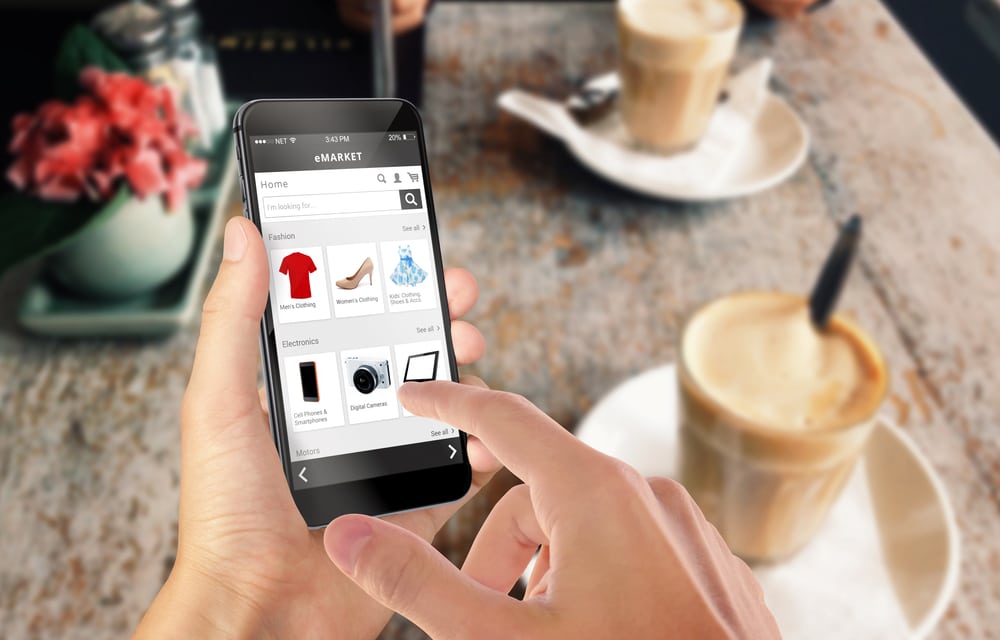In-app advertising has proven effective for many brands and retailers, so why not close the loop with in-app shopping? Mobile capabilities have drastically shortened the consumer path to purchase. By leveraging in-app shopping, brands and retailers can shorten the path even more.
Instagram jumped on the opportunity when the social media platform rolled out its in-app shopping capabilities after finding that more than one-third of users made a purchase through an advertiser on the site. They figured: Why send users away from the site when they could buy directly and continue browsing? With 130 million Instagram users tapping on the shopping tags in a month’s time, it’s clear this product feature is a success. Adidas was one of the pilot partner brands, and they reported a first-quarter sales boost of 40% year-over-year.
Brands and retailers should develop strategies to further take advantage of mobile to be top-of-mind when shoppers want to make purchases directly within an app.
Understanding the Persuasive Appeal of In-App Shopping
“In-app shopping” can have multiple meanings—shopping in a social app, an eCommerce app, a retail- or brand-specific app, or a third-party shopping app. Regardless of which type of app a consumer uses to shop, they’re likely doing so on their mobile devices.
Recent stats provide a glimpse at how popular shopping via a mobile device has become:
- During 2019’s busy holiday shopping season, a third of all online purchases came from smartphone users.
- Not even Black Friday ($7.4 billion in online revenue in 2019) was immune to mobile fever, as nearly 40% of sales on the traditionally brick and mortar shopping day came via a mobile device.
- On Cyber Monday ($9.2 billion in online revenue in 2019) 54% of visitors came from mobile devices, while around 33% purchases on their mobile device, up over 40% from the year before.
Why do shoppers gravitate toward apps to make purchases rather than websites or brick-and-mortars? Consider the following:
- Research shows retail-specific apps have the biggest impact among two groups of constituents: the distant customer, and the offline-only shopper. For infrequent or occasional shoppers, apps enhance the value of the brand and provide greater access to purchase, which can be the defining factor in comparison to a competitor. For the offline shopper, apps provide an entirely new way of interacting with the retailer and engaging with brands. The economic impact is considerable. Among retailers with 100,000 app users, an app can generate incremental sales of $2.3 million.
- Since 2016, retail app usage has skyrocketed more than 50%. Conversion rates have also more than doubled in marketplaces, where shoppers find just what they’re looking for—wide assortment, attractive prices, reward perks, and a seamless user experience. The user-friendly interfaces of mobile apps could be the reason why conversion rates are more than three times higher in apps than on mobile web and two times higher than on eCommerce sites accessed via desktop. Last year, retailers who actively advertised their shopping app participation generated 63% of all transactions from mobile devices. A large number of retailers don’t advertise their app participation, so there is much opportunity to improve.
- In-app shopping is convenient for the busy, on-the-go consumers. Not everyone has the time to drive to a store and scour the aisles, but most people can squeeze in a five-minute virtual shopping session during the day, especially if it’s on a familiar interface used regularly. Shopping via app expediently allows users to make purchases whenever and wherever they want, be it on break, waiting in a line, or while still in bed.
 Another one of the key draws of adding in-app shopping functionality is that it can simplify life for the end user. Instead of downloading dozens of different apps, the user can use one or two robust shopping apps that serve as a sort of virtual shopping mall. Most downloaded apps are used once or twice and then never again. Therefore, it makes sense for retailers and brands to partner with known third party providers in lieu of, or in addition to, having their own branded app.
Another one of the key draws of adding in-app shopping functionality is that it can simplify life for the end user. Instead of downloading dozens of different apps, the user can use one or two robust shopping apps that serve as a sort of virtual shopping mall. Most downloaded apps are used once or twice and then never again. Therefore, it makes sense for retailers and brands to partner with known third party providers in lieu of, or in addition to, having their own branded app.
How to Take Advantage of the In-App Shopping Trend: Form a Partnership
While it may be a first for social media sites, mobile app platforms have been adding in-app purchases to their suite of tools for years to reach shoppers whenever and wherever the urge to shop arises. Forming a partnership with an established app provider could be a quick, easy way to hop on-board the trend of in-app shopping. You’ll be given access to a captive audience of engaged app-users, rather than having to start from scratch.
Shopkick is a mobile shopping app that allows users to earn points (called “kicks”) for engaging with a variety of partnering retailers and brands, in-store or directly within the app. In the app, Shopkickers begin their experience by browsing engaging in-app content from several brands and retailers, whether they’re at home or on-the-go. This content includes curated lookbooks, informative video ads, and more. For partners, this content helps build pre-shop awareness and consideration and puts products at the top of shoppers’ minds. Users can check the Shopkick app to see which brands or retailers offer kicks, which incentivize shoppers to visit a store or make purchases online. By offering users an additional kick incentive for making a purchase, Shopkick closes the loop and drives sales. Eventually, Shopkick users redeem their kicks for free gift cards, which builds a positive affinity and loyalty for the brands and retailers that awarded them.
When eBay was looking to increase exposure to mobile users, the online retailer reached out to Shopkick to gain access to its loyalty program and valuable audience. Shopkick first built intent to shop by curating products and showcasing top offers to drive awareness of product assortment and special promotions. Then Shopkick drove site traffic, app installs, and purchases by motivating with kick rewards. eBay saw positive results across all key metrics including new user acquisition, frequency of purchase, and overall sales volume.
This innovative mobile shopping platform rewards shoppers for engagement while brands and retailers reap the benefits.
Brands and retailers can benefit just as eBay and many others have by forming a partnership with Shopkick. This innovative mobile shopping platform rewards shoppers for engagement while brands and retailers reap the benefits.
It’s simple to develop a partner campaign through Shopkick and enable in-app purchases. Read more success stories or contact Shopkick to learn how to become one of our partners and start capitalizing off in-app purchases.
Image courtesy of Stanisic Vladimir





